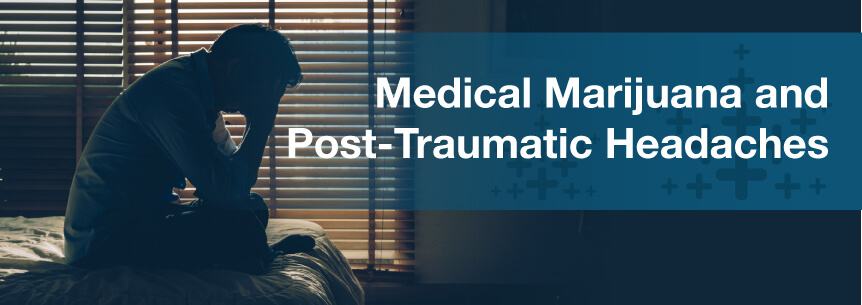
Many individuals experience post-traumatic headaches following a brain injury. Certain studies found using medical marijuana for post-traumatic headaches reduce brain injury damage and can help users alleviate their symptoms.
Each year in the United States, almost 1.7 million people have a traumatic brain injury (TBI), and these can impact theirs and their family’s lives significantly. A common complaint of a traumatic brain injury is a headache, regardless of whether the injury is mild to moderate or severe.
Post-traumatic headaches (PTH) occur after you have an injury to your head or neck, such as a concussion. For that reason, post-traumatic headaches are sometimes called post-concussion headaches. Physicians may also use the term post-traumatic migraine (PTM) to describe this condition.
Common causes of post-traumatic headaches include:
You may experience the pain immediately following the injury, or it could take up to seven days after the event. The combination of swelling and an accumulation of fluid around and in your brain causes these headaches. Because you don’t have any room inside your skull for expanded, swollen tissue, it causes intracranial pressure. Your post-traumatic headache pain level may not have a relationship to the severity of your injury.
Doctors aren’t quite sure of the exact cause of PTH. However, they do think it could be a result of:
If you or a family member has a history of migraines or another type of chronic headache condition, you have a higher likelihood of developing headaches after a traumatic event.
In many cases, patients whose headaches are mild don’t require extensive testing other than a neurologic exam and a consultation of their medical history. But, you may need an MRI or CT scan for severe injuries to rule out a brain bleed.
Here are four of the most common types of post-traumatic headaches.
Migraine headaches occur due to an area of your brain becoming hypersensitive, triggering a pain signal, then spreading to other brain areas. Some symptoms of these headaches include:
You may see bright lights or spots — aura — warning you of an oncoming migraine attack.
Tension-type headaches are linked with muscle spasms, muscle tension and stress. They tend to come with side effects such as:
If you injure your soft tissues or muscles in the back of your head or neck, you may experience cervicogenic headaches. Many nerves in your neck bones and tissues have branches traveling to your scalp and skull, which may lead to head pain. Symptoms tending to come with these headaches include:
In some cases, the medications you use to treat headaches can cause your headaches. When you take pain medications daily, you could end up with a headache if you miss a dose or two. Decreasing your caffeine intake can also cause a rebound headache. For instance, if you’re used to drinking two to three cups of coffee a day — or any other type of caffeinated beverage — and then suddenly stop or miss a day, you could get end up with a rebound headache.
The history of PTH starts in the 19th century. In 2004, the International Headache Classification defined its latest iteration. It’s still unknown how post-traumatic headaches have changed over time. Many explain the natural history of headaches in people with traumatic brain injury — moderate to severe — over five years of injury.
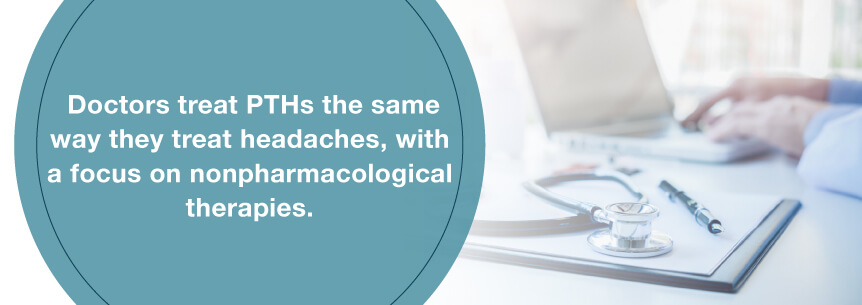
The components of chronic PTH and correlating syndromes are complicated and relate to many psychological, pathophysiological and socioeconomic factors. Doctors treat PTHs the same way they treat headaches, with a focus on nonpharmacological therapies.
Post-traumatic headaches may present many different symptoms, including:
People who experience post-traumatic headaches also may experience changes in their mental capability and functioning, such as:
Most headaches don’t pose any danger. You should see your doctor during the first few days after your head injury, particularly if:
Following a traumatic brain injury, some people’s headaches are chronic. Chronic post-traumatic headache (CPTHA) can affect your function and quality of life drastically. Despite its persistence and high prevalence, there’s little understanding of the mechanisms of CPTHA.
A traumatic brain injury is non-congenital, non-degenerative and may lead to temporary or permanent impairment of physical, cognitive or psychosocial functions, with a correlating altered or reduced state of consciousness.
In a study, one known consequence of traumatic brain injury was chronic pain, with a prevalence rate ranging from 10 to 95 percent, depending how severe the TBI was and the type of pain.
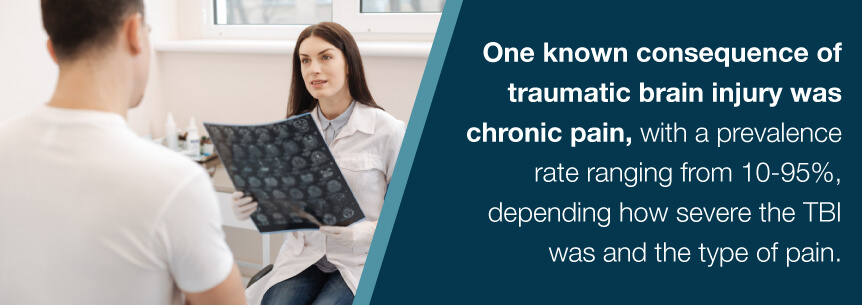
Headache frequency can differ with most patients experiencing weekly or even daily headaches, and fewer patients experiencing monthly headaches. The patients in the study reported their headaches lasting between several minutes to several hours each time. During a headache episode, patients reported their headaches increased gradually with the pain rising to extreme intensities — on a scale of one to 10, their pain was an eight.
Some people have different co-morbidities after a TBI, which can contribute to CPTHA. For instance, traumatic brain injury and post-traumatic stress disorder (PTSD) may co-occur. PTSD is an anxiety disorder developing from being exposed to a potentially life-threatening event. PTSD can also impact CPTHA through an increased level of depression which has also been found recently in patients with a TBI.
Recognizing the psychological factors of post-traumatic headaches is important, as an injury to the head can cause fear, anxiety and resentment more than an injury to other body areas. The accompanying vascular changes and muscle contraction compounded by emotional reactions can further your anxiety and cause a continuous cycle.
A study shows the levels of severity of chronic pain among people after a TBI linking to:
According to the American Migraine Foundation:
The best treatment option depends on each personal case. Talk with your physician about your discomfort and keep track of your headaches, as well as how you’re responding to treatment. Try using a headache diary.
Doctors treat post-traumatic headache treatment based on your symptoms. Medication won’t change the underlying brain disturbance, so doctors treat the symptoms. Here are the x most common treatment methods available.
Usually, treating these types of headaches involve medications like tricyclic antidepressants. These medications reduce both the pain and depression. Side effects may include:
Regular migraine medications like sumatriptan are used to treat headaches with migraine characteristics. Side effects may include:
Your doctor may recommend non-drug therapies. For instance, they may recommend healthy habits like:
Treat psychological factors. Your friends, family or employer should know headaches aren’t just psychological but are related to chemical functions and a disturbed structure in your brain. You may be able to learn pain coping techniques and ways to treat psychological symptoms associated with post-traumatic syndrome by working with a psychologist.
The good news is, most PTHs gradually wear off within a few months. Even if you continue experiencing symptoms longer than a few months, you can still get help.
Around 30 years ago, scientists found marijuana’s bioactive ingredients mimicked the endocannabinoids in your body. Neuro-chemicals control the receptors in your brain to reduce inflammation and pain.
While there’s not a lot of research on the direct effect cannabis has on post-concussion syndrome, certain findings show cannabinoids interact with the CB1 and CB2 receptors of your body. These receptors are part of your endocannabinoid system and work to protect against neural damage resulting from chronic and acute brain damage.
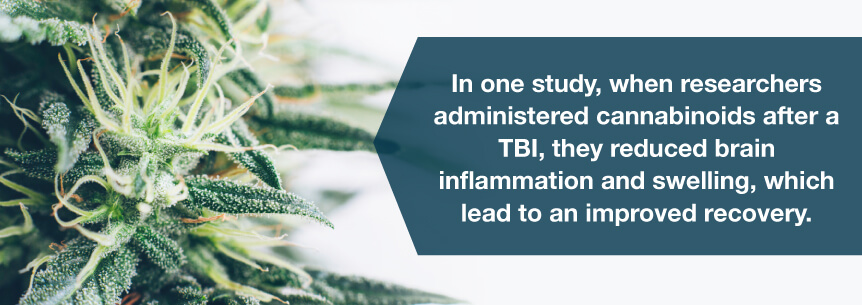
In one study, when researchers administered cannabinoids after a TBI, they reduced brain inflammation and swelling, which lead to an improved recovery.
Marijuana and post-traumatic headaches treatment may heal and protect damaged nerves faster. Studies found PTH patients who used cannabis were able to manage their symptoms better. Medical weed can help combat depression, lower stress, reduce pain and improve sleep. Marijuana for post-traumatic headaches may also help with PTH symptoms such as:
Medical cannabis may only treat your post-traumatic headache symptoms, but there are fewer side effects with the herb, and it’s one treatment addressing many of the condition’s symptoms. Marijuana strains are broken down into two primary ingredients: CBD and THC. Each affects your brain differently, and when you balance them properly, you can find relief from a combination of symptoms.
Use sativa-dominant strains to fight depression, emotional symptoms, migraines and headaches. Indica strains are beneficial for insomnia and pain symptoms.
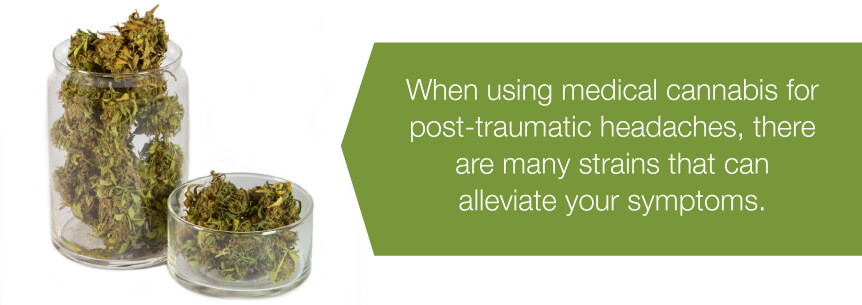
As mentioned earlier, PTH comes with a complete range of symptoms. When using medical cannabis for post-traumatic headaches, there are many strains that can alleviate your symptoms, including the following four most commonly experienced ones.
Strains to try include:
Strains to consider include:
Strains to try include:
Strains to consider include:
A qualified medical cannabis physician can suggest the right cannabis strain to treat your specific post-traumatic headache symptoms. A knowledgeable budtender at a dispensary may also provide you with guidance and insight on strains.
Medical pot ingestion methods affect your mind and body differently. Depending on how you ingest it, your body will use the herb differently. While smoking is the traditional way to use marijuana, there are the different methods to consume your cannabis for post-traumatic headaches treatment, including:
These methods of ingestion are not just good for eliminating smoke, but they also allow you to have some other options for taking your medicine and controlling your dose.
Whether you’re dealing with extreme pain, nausea, depression or loss of appetite from your PTH, you’re sure to find some relief with medical cannabis. People have been reaping the benefits of this herb for a while now. Today, obtaining is getting much easier, too.
Medical cannabis doesn’t give you the risk of overdose and has very few minor side effects. When your doctor guides you, you can stay comfortable while allowing your brain to heal from your injury.
If you don’t have a cannabis doctor yet, search our MarijuanaDoctors.com database to find one your state approves. We’ll connect you to a marijuana doctor nearby to help you obtain your recommendation and take the next steps. Use our resources to find a medical marijuana dispensary or cannabis-friendly doctor near you today.
Find A Doctor Find A Dispensary